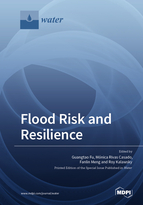Flood Risk and Resilience
A special issue of Water (ISSN 2073-4441). This special issue belongs to the section "Water Resources Management, Policy and Governance".
Deadline for manuscript submissions: closed (30 April 2019) | Viewed by 73306
Special Issue Editors
Interests: artificial intelligence; water system analysis; flood management; system resilience analysis
Special Issues, Collections and Topics in MDPI journals
Interests: surface water flooding; standardised monitoring approaches; systems engineering; disruptive technologies; climate change; extreme events
Special Issues, Collections and Topics in MDPI journals
Interests: modelling and risk and resilience management of urban water systems; optimisation; water policy
Special Issues, Collections and Topics in MDPI journals
Special Issue Information
Dear Colleagues,
Flooding has been increasingly recognized as a global threat due to the extent and magnitude of damage it poses around the world each year. Flooding, which can occur from fluvial, pluvial, coastal and groundwater sources, causes significant economic, social and environmental consequences, and the costs and disruption to communities, businesses and economies are expected to increase as a result of urbanization, economic growth and climate change. For example, flooding is the greatest threat posed by climate change in the UK, with 3.6 million people at risk by the 2050s according to the first UK climate change risk assessment report published in 2012.
To reduce flood losses, we need to understand both current and future risks, develop cost-effective intervention strategies, and increase the resilience of local communities and critical infrastructure to flood events. This requires innovative approaches, advanced computer models and tools to assess flood risk and resilience. In particular, there is a need to understand how resilience can be effectively built into flood defense systems and interlinked critical infrastructure systems in the flood management process. This Special Issue will provide a platform for researchers and engineers to share and discuss state-of-the-art scientific knowledge and best practices in flood management.
This Special Issue aims to address key challenges towards a more flood resilient future, encompassing not only both flood risk and resilience, but also their intersections. It will cover a full suite of flood issues, including, but not limited to, system monitoring and early warning, flood modelling and assessment, structural and non-structural measures, policies and financial instruments, social dynamics and communication by which flood management knowledge within communities is learned and shared.
Prof. Guangtao Fu
Dr. Monica Rivas Casado
Dr. Fanlin Meng
Prof. Roy Kalawsky
Guest Editors
Manuscript Submission Information
Manuscripts should be submitted online at www.mdpi.com by registering and logging in to this website. Once you are registered, click here to go to the submission form. Manuscripts can be submitted until the deadline. All submissions that pass pre-check are peer-reviewed. Accepted papers will be published continuously in the journal (as soon as accepted) and will be listed together on the special issue website. Research articles, review articles as well as short communications are invited. For planned papers, a title and short abstract (about 100 words) can be sent to the Editorial Office for announcement on this website.
Submitted manuscripts should not have been published previously, nor be under consideration for publication elsewhere (except conference proceedings papers). All manuscripts are thoroughly refereed through a single-blind peer-review process. A guide for authors and other relevant information for submission of manuscripts is available on the Instructions for Authors page. Water is an international peer-reviewed open access semimonthly journal published by MDPI.
Please visit the Instructions for Authors page before submitting a manuscript. The Article Processing Charge (APC) for publication in this open access journal is 2600 CHF (Swiss Francs). Submitted papers should be well formatted and use good English. Authors may use MDPI's English editing service prior to publication or during author revisions.
Keywords
- Adaptation strategy
- cascade effect
- community vulnerability
- environmental sustainability
- flood modelling
- flood monitoring
- flood insurance
- mitigation strategy
- resilience analysis
- risk assessment







